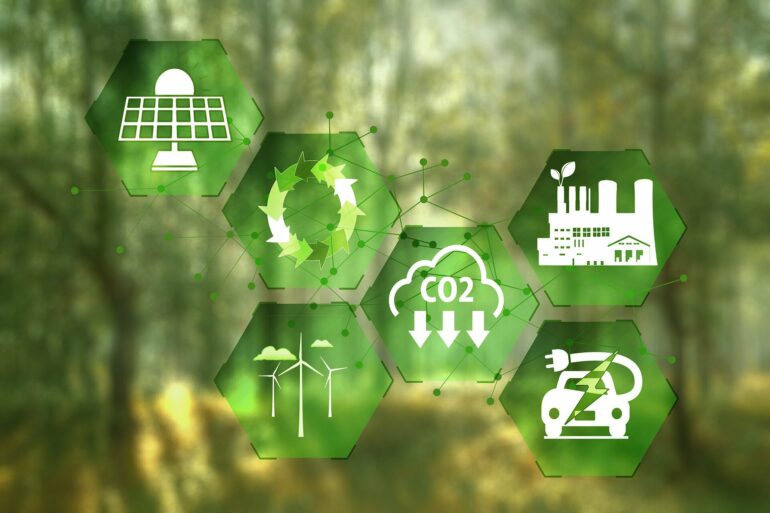Would it be possible to build a refinery that is completely fossil-free, and thereby significantly contributing to a carbon-neutral society by as early as 2050? According to two chemists from Utrecht University it is. In a Nature article, they present a roadmap in which oil refineries could be reinvented to be completely fossil-free. Processes will be electrified if possible, and raw materials will change to CO2, agricultural and municipal waste. “We wanted to see what would be needed to make a fossil-free refinery and took that to the extreme.”
Refineries form the source of most of the world’s transport fuels and are the basis of many products that are essential for everyday life. Refinery processes nowadays predominantly run on fossil fuels, and fossil resources are used for the production of chemicals, pharmaceuticals, and other useful substances. Nevertheless, the use of fossil fuels is the largest contributor to CO2 emissions that drive global climate change.
Although there are clear paths for renewable electricity to largely replace fossil-fuel-based energy, the transport fuels and chemicals produced in current oil refineries will still be needed.
Publishing in the journal Nature—accompanied by an editorial article as well as being featured on the journal cover—Utrecht University researchers Eelco Vogt and Bert Weckhuysen introduce a refinery that is completely carbon-neutral. They use order-of-magnitude calculations for a single refinery plant that they assume to be in Europe, thereby showing what it takes in terms of energy, materials, and resources, as well as the related financial and political constrains.
Integration of components
Some key aspects of the refinery of the future involve the conversion of CO2, plastic and biomass waste into useful raw materials, the production of sustainable hydrogen, and air capture systems to extract CO2.
“However, the vision is the integration of all components needed to build a refinery complex that ultimately becomes zero-waste,” Weckhuysen states. For instance, biomass and plastic waste conversion may produce CO2, but in their innovative concept, this CO2 waste stream is then used to produce sustainable fuels.
Other important details of the future refinery are the requirement of immense amounts of renewable energy, and greater mineral resources for hardware than is the case at present. This, in turn, demands substantially larger land or offshore areas for solar panels and/or wind turbines.
Robust catalysts
Many of the technologies for the future refinery exist in the lab today and require massive scale-up efforts, which is a major challenge. “However, we should not make the mistake to think that we are solely dealing with a problem of scale,” Weckhuysen argues. “Much more scientific and technological work needs to be done, because not everything we can do in the lab will work in real life,” Vogt further adds.
One of the major questions is how to develop robust catalysts that are resistant to the impurities that the new raw material streams will bring. Weckhuysen said, “We do have a vast background and much expertise to handle fossil-derived resources, but this is certainly in its infancy for the renewable resources.”
“What makes it even more challenging, is that we will have to work on these innovations in parallel,” Vogt argues. “We do not have the luxury to wait and see whether a fancy new solution may develop.”
Costs
This level of discovery and innovation requires adequate policies and a long-term support and financing framework, the researchers argue, because the refinery of the future is currently very costly. A new refinery requires investments in the order of 14 to 23 billion euros, the researchers estimate. Just replacing all 615 refineries now operating over the next 25 plus years would require investments on the order of 320 to 520 billion euros per year.
“But of course, long-term global sustainability gains, should be far more relevant than short-term local financial gains,” Vogt says.
Connectors of the future
Apart from the science, technology, adequate policies, and financial support, we should also consider the people who will make our solutions reality, the researchers believe.
“While science and technology can develop solutions, society will have to embrace them,” Weckhuysen argues.
“That is why we need to educate scientists and engineers that can operate in interdisciplinary projects that will make our solutions materialize. This is why we have embraced new educational programs, such as the Da Vinci project at our university, as we need to educate the connectors of the future. We need to keep investing, both in science, technology, and education for the next 25 years to make this transition really work,” states Weckhuysen.
More information:
Bert Weckhuysen, The refinery of the future, Nature (2024). DOI: 10.1038/s41586-024-07322-2. www.nature.com/articles/s41586-024-07322-2
Provided by
Utrecht University, Faculty of Science
Citation:
Chemists present roadmap to a carbon-neutral refinery by 2050 (2024, May 8)


